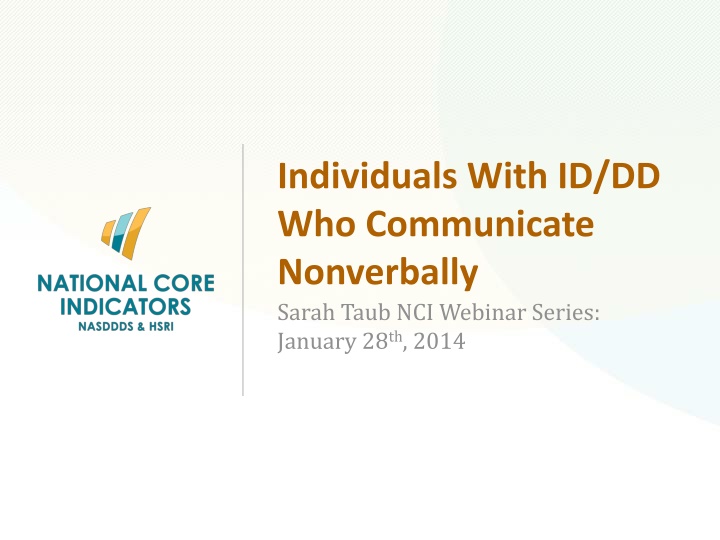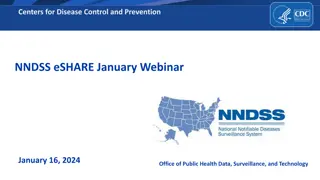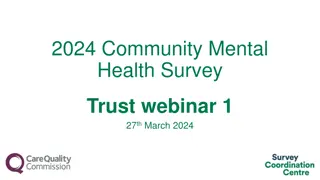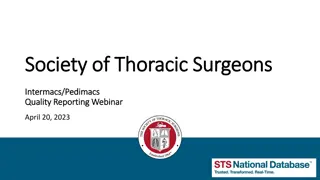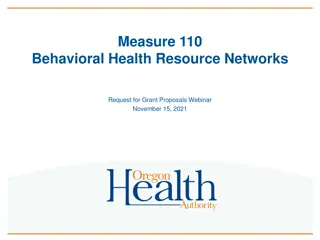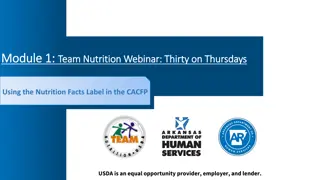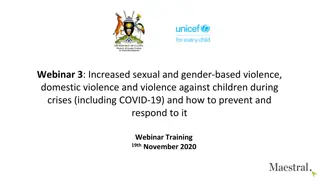National Core Indicators (NCI) for Individuals with ID/DD Who Communicate Nonverbally
Explore the National Core Indicators (NCI), a multi-state collaboration assessing performance in various areas for individuals with intellectual and developmental disabilities who communicate nonverbally. Learn about data collection methods, survey practices, and policy implications for this important research initiative.
Download Presentation

Please find below an Image/Link to download the presentation.
The content on the website is provided AS IS for your information and personal use only. It may not be sold, licensed, or shared on other websites without obtaining consent from the author.If you encounter any issues during the download, it is possible that the publisher has removed the file from their server.
You are allowed to download the files provided on this website for personal or commercial use, subject to the condition that they are used lawfully. All files are the property of their respective owners.
The content on the website is provided AS IS for your information and personal use only. It may not be sold, licensed, or shared on other websites without obtaining consent from the author.
E N D
Presentation Transcript
Individuals With ID/DD Who Communicate Nonverbally Sarah Taub NCI Webinar Series: January 28th, 2014
Agenda Mary Lee Fay, NASDDDS: Intro to NCI Josh Engler and Dorothy Hiersteiner, HSRI: What Do NCI Data Reveal About Individuals With Intellectual and Developmental Disabilities Who Communicate Nonverbally? Celia Feinstein, Temple University- Pennsylvania s Best Practices on Surveying Individuals Who are Nonverbal Jossie Torres and Sandi Geer, Connecticut DDS- Everyone Has a Voice: Experiences as Advocate Interviewers Surveying Individuals Who are Nonverbal National Core Indicators (NCI)
WHAT IS NATIONAL CORE INDICATORS (NCI)? Multi-state collaboration of state DD agencies Measures performance of public systems for people with intellectual and developmental disabilities Assesses performance in several areas, including: employment, community inclusion, choice, rights, and health and safety Launched in 1997 in 13 participating states Supported by participating states NASDDDS HSRI Collaboration National Core Indicators (NCI)
NCI State Participation 2013-14 ME NH WA MA MN OR NY WI SD MI PA NJ OH* DE MD IN IL UT VA Wash DC CO CA* KS KY MO NC TN OK SC AR AZ NM GA AL MS 39 states, the District of Columbia and 22 sub-state regions LA TX FL HI State contract awarded in 2013-14 through AIDD funding CA*- Includes 21 Regional Centers OH*- Also includes the Mid-East Ohio Regional Council
WHAT IS NCI? Adult Consumer Survey In-person conversation with a sample of adults receiving services to gather information about their experiences Keyed to important person-centered outcomes that measure system-level indicators related to: employment, choice, relationships, case management, inclusion, health, etc. Adult Family, Child Family, and Family/Guardian Surveys Mail surveys separate sample from Adult Consumer Survey Other NCI state level data: Mortality, Staff Stability National Core Indicators (NCI)
What Do NCI Data Show Us About Respondents Who Communicate Verbally & Those Who Communicate Nonverbally? Agenda Data source Methods, Measures and Sample Findings Limitations Policy Implications National Core Indicators (NCI)
Data Source: Adult Consumer Survey Standardized, face-to-face interview with a sample of individuals receiving services Background Information Section I (no proxies allowed) Section II (proxies allowed) No pre-screening procedures states don t filter anyone out of the sample. Conducted with adults only (18 and over) receiving at least one service in addition to case management Section I and Section II together take 50 minutes (on average) National Core Indicators (NCI)
Methods, Measures and Sample: 2011-2012 data collection cycle Background Information section: demographics, residence, health, and employment information. Generally collected from records by case managers. 19 states, one regional council (AL, AR, AZ, CT, GA, HI, IL, KY, LA, MA, ME, MI, MO, NC, NJ, NY, OH, PA, SC and the Mid-East Ohio Regional Council) Total N: 12,236 individuals National Core Indicators (NCI)
Methods, Measures and Sample: Source: Background Section What is this person s primary means of expression? __ 1 Spoken __ 2 Gestures/body language __ 3 Sign language or finger spelling __ 4 Communication aid/device __ 5 Other __ 6 Don t know Included in sample only those cases for which a response to this question was provided Final sample size: 12,041 Individuals Items combined to create: Verbal variable Communicate verbally Communicate nonverbally National Core Indicators (NCI)
Nonverbal Respondents to the ACS Sec. I of the ACS ONLY individual receiving services Section II of ACS proxy allowed Nonverbal Verbal 100% 86% 85% 90% 80% 70% 60% 50% 40% 33% 28% 30% 20% 10% 0% Was able to complete Section I Answered Section II questions without proxy National Core Indicators (NCI)
FINDINGS For the purpose of this webinar, only group differences that were significant at the p<.01 level are reported. KEEP IN MIND: These analyses do not control for other factors that may influence results. For example, differences in outcomes may be influenced by differences in demographic and personal characteristics such as: State, age, socio-economic status, gender, level of disability, mobility level, etc. Need for additional research on this topic. National Core Indicators (NCI)
Sample Primary means of communication Communicate verbally Percent of total 76 % Communicate nonverbally 24% Total (N=12,041) 100.0% Of those who communicate nonverbally 6%4%7% Gestures/body language Sign language/finger spelling Communication aid/device 83% Other National Core Indicators (NCI)
Demographics: Percentage of Respondents of Indicated Race/Ethnicity who Communicate Verbally 100% 90% 78% 78% 80% 74% 74% 72% 70% 62% 56% 60% 50% 40% 30% 20% 10% 0% American Indian or Alaska Native (N=99) Asian (N=274) Black or African American (N=2280) Pacific Islander (N=82) White (N=8655) Other race not listed (N=336) Hispanic (N=517) National Core Indicators (NCI)
Demographics: Level of Disability 100% No ID/DD Label 90% Mild ID/DD 80% Moderate ID/DD 70% Severe ID/DD 60% 47% Profound ID/DD 50% 46% 40% Unspecified level of ID/DD ID/DD level unknown 33% 26% 30% 20% 14% 10% 6% 10% 4% 3% 3% 3% 3% 2% 1% 0% Nonverbal Verbal National Core Indicators (NCI)
Demographics: Additional Diagnoses Nonverbal 100% 90% Verbal 80% 70% 60% 50% 40% 38% 40% 25% 30% 20% 21% 18% 17% 20% 13% 11% 11% 10% 10% 8% 8% 5% 4% 10% 1% 0% 0% National Core Indicators (NCI)
Demographics: Mobility Level 100% 90% 83% Nonverbal 80% Verbal 70% 55% 60% 50% 40% 28% 30% 17% 20% 13% 10% 3% 0% Moves self around environment without aids Moves self around environment with aids or uses wheelchair independently Non-ambulatory, always needs assistance National Core Indicators (NCI)
Demographics: Amount of Staff Support 100% 90% Nonverbal 80% 70% Verbal 70% 60% 52% 50% 40% 30% 21% 20% 14% 12% 12% 9% 6% 10% 4% 2% 0% 24-hour on-site support or supervision Daily on-site support Scheduled, less frequent than daily support As needed visitation and phone contact None of the above National Core Indicators (NCI)
Health: Reported Health Status Nonverbal 100% Verbal 90% 80% 70% 62% 60% 54% 50% 42% 40% 31% 30% 20% 7% 10% 4% 0% Excellent or Very Good Fairly Good Poor National Core Indicators (NCI)
Health: 100% 93% 90% Nonverbal 90% Verbal 80% 70% 60% 50% 40% 30% 20% 10% 0% Had a routine physical exam in the past year National Core Indicators (NCI)
Home: Type Of Residence 100% 90% Nonverbal 80% Verbal 70% 60% 50% 42% 37% 40% 35% 31% 30% 20% 15% 12% 6% 6% 10% 5% 5% 4% 2% 0% Institution Community-based residence Independent home/apt Parents'/relatives' home Foster care/host home Other National Core Indicators (NCI)
Home: Satisfaction with Residence Nonverbal 100% 95% 93% 90% 88% Verbal 90% 80% *= Question comes from Section I of the ACS 70% 60% 50% 40% 27% 30% 20% 20% 10% 0% Likes where lives* Would like to live somewhere else* Likes neighborhood* National Core Indicators (NCI)
Work/Day Activity: Work/Day Activity (In Past Two Weeks) Nonverbal 100% Verbal 90% 80% 70% 59% 60% 46% 50% 40% 32% 30% 22% 18% 17% 20% 11% 10% 2% 0% Paid community job Unpaid community activity Paid facility-based work Unpaid facility-based activity National Core Indicators (NCI)
Safety: 100% Nonverbal 90% Verbal 80% 70% 60% 50% 40% 30% 20% 14% 10% 8% 8% 10% 5% 5% 4% 4% 0% Afraid at home most of the time* Afraid in neighborhood most of the time* Afraid at work/day program most of the time* If you ever feel afraid, there isn't anyone to whom you can go for help* *= Question comes from Section I of the ACS National Core Indicators (NCI)
Relationships: 100% Nonverbal 90% 84% Verbal 76% 80% 72% 68% 70% 65% 60% 55% 50% 40% 40% 34% 30% 20% 10% 0% Has friends* Has a best friend* Able to go on dates without restrictions (or married)* Feels lonely at least half of the time* *= Question comes from Section I of the ACS National Core Indicators (NCI)
Community Participation: Percentage of Respondents Who Participated in Selected Community Activities in the Past Month 100% 91% 87% 86% 90% 81% Nonverbal 77% 80% 73% 73% Verbal 68% 70% 59% 60% 50% 51% 48% 50% 40% 35% 40% 30% 20% 10% 0% Shopping** Errands** Entertainment** Eating out** Religious activity** Exercise** Vacation ^ ** ** = Question comes from Section II of the ACS ^ = Percentage indicates number of respondents who went on vacation in the past year National Core Indicators (NCI)
Choices: 100% 95% 94% Non-Verbal 87% 90% Verbal 76% 80% 67% 70% 65% 60% 58% 57% 60% 47% 50% 43% 40% 34% 30% 21% 17% 20% 10% 0% Chose Home** Chose Choosing schedule** Choosing what to do in freetime** Chose day activity** Choosing what to buy** Chose case manager** roommates** ** = Question comes from Section II of the ACS National Core Indicators (NCI)
Rights and Respect: 100% 92% Nonverbal 87% 90% 81% Verbal 80% 74% 70% 60% 50% 40% 28% 30% 19% 17% 20% 12% 10% 0% Mail is read without permission** Can be alone with guests** Can use phone or internet without restrictions** Has participated in a self-advocacy activity** ** = Question comes from Section II of the ACS National Core Indicators (NCI)
Why? Differences in the demographics and valued outcomes Relationships, Home, Rights & respect, Inclusion, Personal safety, Choice, Health and Employment Help inform state officials, providers and advocates to forge future policies and supports for individuals who do not use words to speak. What policy implications can you think of? National Core Indicators (NCI)
Contacts HSRI Josh Engler: jengler@hsri.org Dorothy Hiersteiner: dhiersteiner@hsri.org NASDDDS Mary Lee Fay: MLFay@nasddds.org NCI website: www.nationalcoreindicators.org National Core Indicators (NCI)
Celia Feinstein, Temple University Pennsylvania s Best Practices on Surveying Individuals Who are Nonverbal National Core Indicators (NCI)
What To Do if a Person has Difficulty with Communication Meet with the person. Spend time with the person, observing how the person interacts (or doesn t interact) with other people. (handout) Find out who knows the person best. 31
What To Do if a Person has Difficulty with Communication Enlist the assistance of the people most familiar with the person and his or her style of communication in the interview process. Ask the person for suggestions and direction. Interview as many people who are very close to the person as possible. 32
What PA is Doing Regarding People Who Do Not Communicate Using Words Look at IM4Q/NCI data Picture response formats Communication pilots PAC Quality Management Committee 33
Language/Behavior Cultural Sensitivity/Cultural Communication Use People First Language (handout) 34
CT Presenters: Jossie Torres and Sandi Geer Jossie Torres, a Self Advocate Coordinator for the Department of Development Services. She has been employed for nine years has been implementing NCI Surveys when CT participated. Sandi Geer, the Self Determination/Employment Specialist for the Department of Developmental Services. She has been employed with the state for 29 years. She has been part of the NCI survey team for the past 3 years.
CT has 10 Self Advocate Coordinators (SACs) who are state employees All SACs are trained and have been asking the NCI questions for several years
Statewide Training All participated in the trainings held statewide to provide overview of NCI Regional Training All participated in the Regional training for all NCI Surveyors SAC Training Used the training from
Everyone should have the opportunity to be surveyed if THEY choose to be even if they have difficulty communicating Everyone should be given the opportunity to have a VOICE and be part of the survey
Be prepared to communicate on the phone. Family or staff may be the one on the other end of the phone letting you know that the person you want to speak to is non-verbal Be Positive importance of everyone s voice Ask about their form of communication. How do they know what they like or dislike? prepared that not everyone will have a way Positive and reassuring to the person the
Promote voice. Provide First section of the survey is the individual s response only. BUT surveyor will use any form of communication the person is comfortable using. Communication Board, Pictures, IPAD, Speech Talkers, etc. Promote the importance of each person s Provide information about the survey - The
The second section of the survey can be done with their support person Encourage the person on the phone to be part of the survey and assist the individual to have a VOICE
Ask the family/support person where and when the individual can meet and where they would be most comfortable. Remind them they are welcome to be present during the first part of the survey and assist with the second part of the survey. The day before the meeting, call to remind the family/support person of the meeting by stating your name, and the date, time and place of meeting.
Take your time when you arrive to do your survey. Make sure you are both comfortable before you begin. Make sure to bring materials to try to get across the survey questions in a different way so they have every opportunity to understand the questions. Introduce yourself and thank the person for meeting with you. Ask if the person has any questions for you. Ask all the questions, but remind the person it is ok not to answer questions and that there are no right or wrong answers.
How do I have the conversation with a person who can not communicate verbally to get the answers to the NCI questions? Talk to the person as you would anyone else. Use any form of accommodation allowing the person to feel safe and comfortable in talking with you. Provide alternative ways to ask and answer questions
Be aware how the person responds to you and the questions. Eye contact Facial expressions Body language Take your time with the questions. Give the person time to answer the questions at their own pace. Remember to use eye contact when asking the questions and waiting for their response This indicates you value what they have to say
Consider using visual communication tools to assist you in the Survey Using the colors Red (NO) and Green (YES) to assist in answering Printed faces with expressions Pictures of places, people, employment options and other pictures that relate to the NCI questions.
Happy/Yes Happy/Yes Sad/NO Sad/NO I m Tired and want to STOP! I m Tired and want to STOP!
Home Country Apartment City
Post Secondary Education Want a new job! Desk Job Helping Jobs
